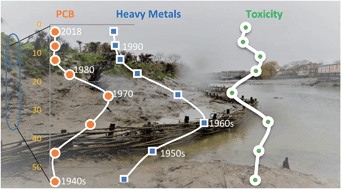当前位置:
X-MOL 学术
›
Environ. Sci.: Processes Impacts
›
论文详情
Our official English website, www.x-mol.net, welcomes your
feedback! (Note: you will need to create a separate account there.)
Trends in heavy metals, polychlorinated biphenyls and toxicity from sediment cores of the inner River Thames estuary, London, UK.
Environmental Science: Processes & Impacts ( IF 4.3 ) Pub Date : 2020-01-16 , DOI: 10.1039/c9em00430k Christopher H Vane 1 , Grenville H Turner , Simon R Chenery , Martin Richardson , Mark C Cave , Ricky Terrington , Charles J B Gowing , Vicky Moss-Hayes
Environmental Science: Processes & Impacts ( IF 4.3 ) Pub Date : 2020-01-16 , DOI: 10.1039/c9em00430k Christopher H Vane 1 , Grenville H Turner , Simon R Chenery , Martin Richardson , Mark C Cave , Ricky Terrington , Charles J B Gowing , Vicky Moss-Hayes
Affiliation

|
River islands (Ait or Eyot) within the inner tidal Thames serve as unique recorders of current and historical estuarine chemical pollution. Sediment cores from Chiswick Ait were assessed for contamination using Microtox® solid phase bioassay, stable isotopes (δ13C, δ15N), heavy metals and polychlorinated biphenyls (PCBs). Microtox® classified these sediments as non-toxic to moderately toxic and bulk isotopes identified a change in organic input. Metals Cu, Zn, Cr, Ni, Cd, Hg and Ag showed parallel rise, peak and fall profiles which when allied to a 207/208Pb and 137Cs based chronology supported major changes in trace metal contributions corresponding to approximate input times of 1940 (rise), 1963 (peak) and 1985 (fall). Metals ranged from Cu 15 to 373 mg kg-1 (mean 141 mg kg-1), Zn 137 to 1331 mg kg-1 (mean 576 mg kg-1), Cr 14-351 mg kg-1 (mean 156 mg kg-1), Pb 10 to 1506 mg kg-1 (mean 402 mg kg-1), As 1 to 107 (mean 38 mg kg-1), Ni 11 to 113 mg kg-1 (mean 63 mg kg-1), Cd 0.2 to 53 mg kg-1 (mean 9 mg kg-1), Hg 1 to 8 mg kg-1 (mean 4.6 mg kg-1) and Ag from 0.7 to 50 mg kg-1 (mean 7.5 mg kg-1). Down core total PCBs ranged from 10.5 to 121 μg kg-1 and mean of 39 μg kg-1. The rise, peak and fall of Cu, Zn, Cr, Ni, Cd and Ag pollution matched local sewage works' treatment discharge records. Whereas the Hg, Pb and As profiles were disconnected, reflecting alternative historic sources and or partitioning behaviour. Comparison to marine sediment quality guidelines indicate that Zn, Pb, Ni, Cd and Hg exceed action level 2, whereas sedimentary Cu, Cr and As concentrations were above action level 1 (no action) but below action level 2 (further investigation required). The river islands of the tidal Thames capture a unique contaminant chemistry record due in part to their location in the tidal frame (salinity minimum) and close proximity to west London.
中文翻译:

英国伦敦泰晤士河内河口沉积物芯的重金属,多氯联苯和毒性的趋势。
泰晤士河内的河道(Ait或Eyot)是当前和历史河口化学污染的独特记录者。使用Microtox®固相生物测定法,稳定同位素(δ13C,δ15N),重金属和多氯联苯(PCB)对Chiswick Ait的沉积物芯进行了污染评估。Microtox®将这些沉积物归类为无毒到中度毒性,大块同位素确定了有机物输入的变化。金属Cu,Zn,Cr,Ni,Cd,Hg和Ag显示出平行的上升,峰值和下降曲线,当与基于207 / 208Pb和137Cs的年代相关时,支持痕量金属贡献的重大变化,对应于1940年的近似输入时间(上升),1963年(峰值)和1985年(秋季)。金属的含量范围为Cu 15至373 mg kg-1(平均141 mg kg-1),Zn 137至1331 mg kg-1(平均576 mg kg-1),Cr 14-351 mg kg-1(平均156 mg kg-1),Pb 10至1506 mg kg-1(平均402 mg kg-1),As 1至107(平均38 mg kg-1),Ni 11至113 mg kg-1(平均63 mg kg-1),Cd 0.2至53 mg kg-1(平均9 mg kg-1),Hg 1至8 mg kg-1(平均4.6 mg kg-1)和Ag 0.7至50 mg kg-1(平均7.5 mg kg-1)。下芯总PCB的范围为10.5至121μgkg-1,平均值为39μgkg-1。铜,锌,铬,镍,镉和银污染的上升,下降和下降符合当地污水处理厂的处理排放记录。汞,铅和砷的分布是断开的,反映了替代的历史来源和/或分区行为。与海洋沉积物质量指南的比较表明,Zn,Pb,Ni,Cd和Hg超过了作用水平2,而沉积的Cu,Cr和As浓度高于作用水平1(无作用)但低于作用水平2(需要进一步研究)。
更新日期:2020-02-26
中文翻译:

英国伦敦泰晤士河内河口沉积物芯的重金属,多氯联苯和毒性的趋势。
泰晤士河内的河道(Ait或Eyot)是当前和历史河口化学污染的独特记录者。使用Microtox®固相生物测定法,稳定同位素(δ13C,δ15N),重金属和多氯联苯(PCB)对Chiswick Ait的沉积物芯进行了污染评估。Microtox®将这些沉积物归类为无毒到中度毒性,大块同位素确定了有机物输入的变化。金属Cu,Zn,Cr,Ni,Cd,Hg和Ag显示出平行的上升,峰值和下降曲线,当与基于207 / 208Pb和137Cs的年代相关时,支持痕量金属贡献的重大变化,对应于1940年的近似输入时间(上升),1963年(峰值)和1985年(秋季)。金属的含量范围为Cu 15至373 mg kg-1(平均141 mg kg-1),Zn 137至1331 mg kg-1(平均576 mg kg-1),Cr 14-351 mg kg-1(平均156 mg kg-1),Pb 10至1506 mg kg-1(平均402 mg kg-1),As 1至107(平均38 mg kg-1),Ni 11至113 mg kg-1(平均63 mg kg-1),Cd 0.2至53 mg kg-1(平均9 mg kg-1),Hg 1至8 mg kg-1(平均4.6 mg kg-1)和Ag 0.7至50 mg kg-1(平均7.5 mg kg-1)。下芯总PCB的范围为10.5至121μgkg-1,平均值为39μgkg-1。铜,锌,铬,镍,镉和银污染的上升,下降和下降符合当地污水处理厂的处理排放记录。汞,铅和砷的分布是断开的,反映了替代的历史来源和/或分区行为。与海洋沉积物质量指南的比较表明,Zn,Pb,Ni,Cd和Hg超过了作用水平2,而沉积的Cu,Cr和As浓度高于作用水平1(无作用)但低于作用水平2(需要进一步研究)。











































 京公网安备 11010802027423号
京公网安备 11010802027423号